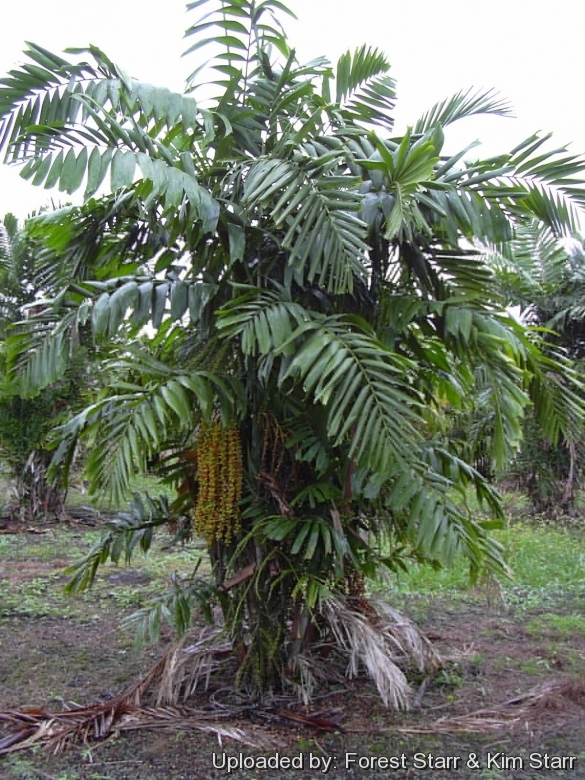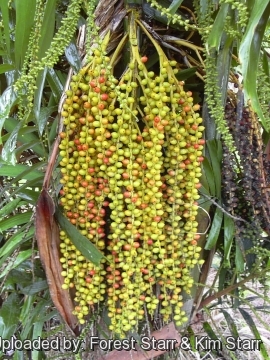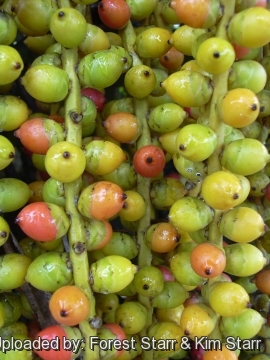Accepted Scientific Name: Arenga tremula (Blanco) Becc.
Philipp. J. Sci., C 4: 612 1909

Didymosperma tremulum (Arenga tremula) Photo by: Forest Starr & Kim Starr
Habit at Hilo, Hawaii. November 18, 2003.
Origin and Habitat: Endemic to the Philippines (Luzon, Mindoro)
Habitat: Philippine rainforest in secondary forests and thickets at low altitudes.
Synonyms:
Common Names include:
ENGLISH: Arenga, Arenga Palm, Dwarf sugar palm, Philippines dwarf sugar palm
CHINESE (中文): Fei lü bin guang lang
Description: Arenga tremula is a multistemmed, naturally clumping, feathery leafed palm which forms a wide-spreading shrub with a decidedly tropical look. It grows slowly up to 3- 4 metres tall and 2,5 m wide (in shade) up to 5 m wide (in sunnier locations). It is Monocarpic, but only stem that produces flower dies, while rest of plant keeps on growing.
Trunks: Few, short up to 6 cm in diameter near the base, tapering, covered with old, shredded leaf sheaths and with a black netting close to crownshaft. The netting can fall off as the palm ages and reveal a green ringed trunk.
Roots: Root system adventitious, typical of monocots. As it matures, an arenga forms aerial roots that push it above the soil surface, which helps provide good drainage for the health of the plant.
Flowers: Flowers either male or female, in separate, pendulous inflorescences arising from the stem, each with several rachillae; female rachillae usually longer and more numerous than male rachillae.
Leaves (fronds): Pinnate, 3-6 m long, arching from the base; leaflets divaricate, linear, up to 80 cm long, base constricted with a small lobe, apex truncate and finely toothed, light green on top and silvery green beneath; petiole 1.5- 2 m long.
Flowering period: Blooms in Summer.
Fruits: Globose, to 1.5 cm in diameter, smooth, with thin epidermis and scanty pulp, usually 2-seeded, ripening yellow then bright red.
Bibliography: Major references and further lectures
1) Forest & Kim Starr “Arenga tremula (Philippine dwarf sugar palm)”. Plants of Hawaii. <http://www.starrenvironmental.com>. Downloaded on 20 August 2014. Alice
2) Robert Lee Riffle, Paul Craft “An Encyclopedia of Cultivated Palms” Timber Press, Portland 2007
3) John Dransfield, Natalie W. Uhl, Conny B. Asmussen, William J. Baker, Madeline M. Harley, Carl E. Lewis: “Genera Palmarum. The Evolution and Classification of Palms.” Royal Botanic Gardens, Kew 2008
4) Don Ellison, Anthony Ellison “Cultivated Palms of the World” UNSW Press, 2001
 Fruits at Hilo, Hawaii. November 18, 2003. (Arenga tremula) Photo by: Forest Starr & Kim Starr
Fruits at Hilo, Hawaii. November 18, 2003. (Arenga tremula) Photo by: Forest Starr & Kim Starr Fruits at Hilo, Hawaii. November 18, 2003. (Arenga tremula) Photo by: Forest Starr & Kim Starr
Fruits at Hilo, Hawaii. November 18, 2003. (Arenga tremula) Photo by: Forest Starr & Kim StarrCultivation and Propagation: This is an handsome palm with easy to manage nature. It can be grow indoors in a container for years before out growing the pot, but looks much better when planted in the ground and will thrive if given a spot in light shade.
Growth Rate: Slow.
Soil: They prefers well draining, porous soils rich in humus. (but can even grow in swampy terrain). Amend the soil with organic peat moss or top soil when you plant.
Light: They do well in sunny position, but the arenga keep their best deep green colour in partial to full shade, if indoors place in a position where it will get some sun during the day. Seedlings like a more sheltered area.
Watering: In cultivation they appreciates abundant waterings. During the summer or warmer months, water frequently to keep the soil from drying out.
Fertilization: Need a perfect fertilizer diet including all micro nutrients and trace elements or slow release fertilizer. Apply fertilizer 3 times a year, in spring, summer and fall...and if the palm is planted in full sun, fertilize more often. In a full sun location the fronds tend to turn lime-green or yellow, so the extra fertilization helps prevent this discolouration.
Hardiness: Although it is from the tropics and sub-tropics it is able to take temperatures around freezing point for a short time. However it can be difficult to get it to look its best without a great amount of heat and sun and so it is only really suited to the tropics in frost-free regions (USDA Zones 10-12)
Maintenance: These palms aren't considered self-cleaning but you'll only need to trim off an old frond occasionally.
Propagation Method: Seed.











